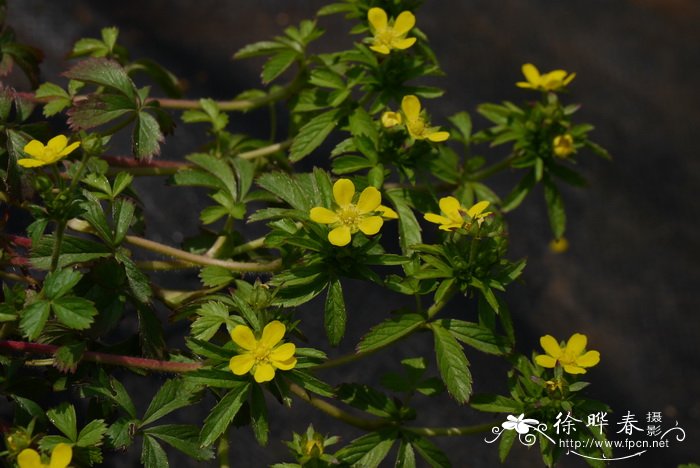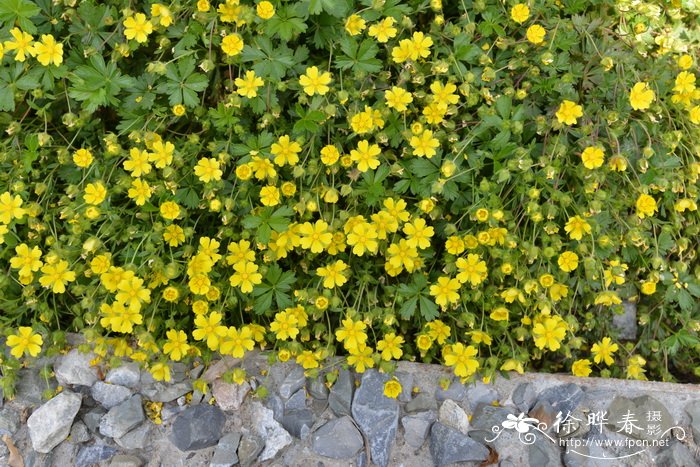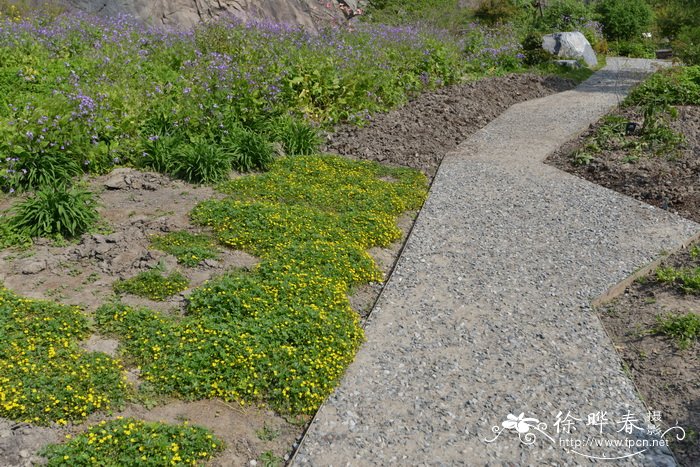蛇含委陵菜 Potentilla kleiniana
中文名(Chinese Name):蛇含委陵菜
学名(Scientific Name):Potentilla kleiniana Wight et Arn.
英文名(English Common Name):
别名(Chinese Common Name):蛇含
异名(Synonym):Potentilla bodinieri H. Lév. Potentilla anemonifolia Lehm. Potentilla sundaica (Blume) W.Theob.
科属(Family & Genus):蔷薇科(Rosaceae)委陵菜属
形态特征(Description):一年生、二年生或多年生宿根草本。多须根。花茎上升或匍匐,常于节处生根并发育出新植株,长10-50厘米,被疏柔毛或开展长柔毛。基生叶为近于鸟足状5小叶,连叶柄长3-20厘米,叶柄被疏柔毛或开展长柔毛;小叶几无柄稀有短柄,小叶片倒卵形或长圆倒卵形,长0.5-4厘米,宽0.4-2厘米,顶端圆钝,基部楔形,边缘有多数急尖或圆钝锯齿,两面绿色,被疏柔毛,有时上面脱落几无毛,或下面沿脉密被伏生长柔毛,下部茎生叶有5小叶,上部茎生叶有3小叶,小叶与基生小叶相似,唯叶柄较短;基生叶托叶膜质,淡褐色,外面被疏柔毛或脱落几无毛,茎生叶托叶草质,绿色,卵形至卵状披针形,全缘,稀有1-2齿,顶端急尖或渐尖,外被稀疏长柔毛。聚伞花序密集枝顶如假伞形,花梗长1-1.5厘米,密被开展长柔毛,下有茎生叶如苞片状;花直径0.8-1厘米;萼片三角卵圆形,顶端急尖或渐尖,副萼片披针形或椭圆披针形,顶端急尖或渐尖,花时比萼片短,果时略长或近等长,外被稀疏长柔毛;花瓣黄色,倒卵形,顶端微凹,长于萼片;花柱近顶生,圆锥形,基部膨大,柱头扩大。瘦果近圆形,一面稍平,直径约0.5毫米,具皱纹。花果期4-9月。
分布(Distribution):产我国大部分省区,生海拔400-3000米田边、水旁、草甸及山坡草地。朝鲜、日本、印度、马来西亚及印度尼西亚均有分布。
用途(Use):全草供药用,有清热、解毒、止咳、化痰之效,捣烂外敷治疮毒、痛肿及蛇虫咬伤。
引自中国植物志英文版:FOC Vol. 9 Page 321
Potentilla kleiniana Wight & Arnott, Prodr. Fl. Ind. Orient. 300. 1834.
蛇含委陵菜 she han wei ling cai| Rosaceae | Potentilla
Potentilla anemonifolia Lehmann; P. bodinieri H. Léveillé.
Herbs annual, biennial, or perennial. Flowering stems prostrate or ascending, 10–50 cm tall, together with petioles pilose or spreading villous, usually rooting at nodes and developing new plants. Radical leaves 3–20 cm including petiole; stipules tinged brown, membranous, abaxially pilose or glabrescent; leaf blade subpedately 5-foliolate; leaflets subsessile or shortly petiolulate, both surfaces green, obovate or oblong-obovate, 0.5–4 × 0.4–2 cm, both surfaces pilose, abaxially densely appressed villous on veins, adaxially sometimes glabrescent, base cuneate, margin acutely or obtusely many serrate, apex obtuse; lower cauline leaves 5-foliolate, upper ones 3-foliolate; stipules green, ovate or ovate-lanceolate, herbaceous, abaxially sparsely villous, margin entire, rarely acutely or acuminately 1- or 2-serrate; petiole gradually shorter higher up stem; leaflets resembling those of radical leaves. Inflorescence terminal, cymose, congested, pseudoumbellate. Flowers 0.8–1 cm in diam.; pedicel 1–1.5 cm, densely spreading villous, bracteate. Sepals triangular-ovate, apex acute or acuminate; epicalyx segments lanceolate or elliptic-lanceolate, shorter than sepals at anthesis, nearly equaling or slightly longer than sepals in fruit, abaxially pilose, apex acute or acuminate. Petals yellow, obovate, longer than sepals, apex emarginate. Style subterminal, conic, base thickened; stigma dilated. Achenes subglobose, flattened on 1 side, ca. 0.5 mm in diam., rugose. Fl. and fr. Apr–Sep.
Meadows, grasslands on mountain slopes, field margins; 400--3000 m. Anhui, Fujian, Guangdong, Guangxi, Guizhou, Henan, Hubei, Hunan, Jiangsu, Jiangxi, Liaoning, Shaanxi, Shandong, Sichuan, Xizang, Yunnan, Zhejiang [Bhutan, India, Indonesia, Japan, Korea, Malaysia, Nepal, Sikkim].
This species is used medicinally.



(责任编辑:徐晔春)
学名(Scientific Name):Potentilla kleiniana Wight et Arn.
英文名(English Common Name):
别名(Chinese Common Name):蛇含
异名(Synonym):Potentilla bodinieri H. Lév. Potentilla anemonifolia Lehm. Potentilla sundaica (Blume) W.Theob.
科属(Family & Genus):蔷薇科(Rosaceae)委陵菜属
形态特征(Description):一年生、二年生或多年生宿根草本。多须根。花茎上升或匍匐,常于节处生根并发育出新植株,长10-50厘米,被疏柔毛或开展长柔毛。基生叶为近于鸟足状5小叶,连叶柄长3-20厘米,叶柄被疏柔毛或开展长柔毛;小叶几无柄稀有短柄,小叶片倒卵形或长圆倒卵形,长0.5-4厘米,宽0.4-2厘米,顶端圆钝,基部楔形,边缘有多数急尖或圆钝锯齿,两面绿色,被疏柔毛,有时上面脱落几无毛,或下面沿脉密被伏生长柔毛,下部茎生叶有5小叶,上部茎生叶有3小叶,小叶与基生小叶相似,唯叶柄较短;基生叶托叶膜质,淡褐色,外面被疏柔毛或脱落几无毛,茎生叶托叶草质,绿色,卵形至卵状披针形,全缘,稀有1-2齿,顶端急尖或渐尖,外被稀疏长柔毛。聚伞花序密集枝顶如假伞形,花梗长1-1.5厘米,密被开展长柔毛,下有茎生叶如苞片状;花直径0.8-1厘米;萼片三角卵圆形,顶端急尖或渐尖,副萼片披针形或椭圆披针形,顶端急尖或渐尖,花时比萼片短,果时略长或近等长,外被稀疏长柔毛;花瓣黄色,倒卵形,顶端微凹,长于萼片;花柱近顶生,圆锥形,基部膨大,柱头扩大。瘦果近圆形,一面稍平,直径约0.5毫米,具皱纹。花果期4-9月。
分布(Distribution):产我国大部分省区,生海拔400-3000米田边、水旁、草甸及山坡草地。朝鲜、日本、印度、马来西亚及印度尼西亚均有分布。
用途(Use):全草供药用,有清热、解毒、止咳、化痰之效,捣烂外敷治疮毒、痛肿及蛇虫咬伤。
引自中国植物志英文版:FOC Vol. 9 Page 321
Potentilla kleiniana Wight & Arnott, Prodr. Fl. Ind. Orient. 300. 1834.
蛇含委陵菜 she han wei ling cai| Rosaceae | Potentilla
Potentilla anemonifolia Lehmann; P. bodinieri H. Léveillé.
Herbs annual, biennial, or perennial. Flowering stems prostrate or ascending, 10–50 cm tall, together with petioles pilose or spreading villous, usually rooting at nodes and developing new plants. Radical leaves 3–20 cm including petiole; stipules tinged brown, membranous, abaxially pilose or glabrescent; leaf blade subpedately 5-foliolate; leaflets subsessile or shortly petiolulate, both surfaces green, obovate or oblong-obovate, 0.5–4 × 0.4–2 cm, both surfaces pilose, abaxially densely appressed villous on veins, adaxially sometimes glabrescent, base cuneate, margin acutely or obtusely many serrate, apex obtuse; lower cauline leaves 5-foliolate, upper ones 3-foliolate; stipules green, ovate or ovate-lanceolate, herbaceous, abaxially sparsely villous, margin entire, rarely acutely or acuminately 1- or 2-serrate; petiole gradually shorter higher up stem; leaflets resembling those of radical leaves. Inflorescence terminal, cymose, congested, pseudoumbellate. Flowers 0.8–1 cm in diam.; pedicel 1–1.5 cm, densely spreading villous, bracteate. Sepals triangular-ovate, apex acute or acuminate; epicalyx segments lanceolate or elliptic-lanceolate, shorter than sepals at anthesis, nearly equaling or slightly longer than sepals in fruit, abaxially pilose, apex acute or acuminate. Petals yellow, obovate, longer than sepals, apex emarginate. Style subterminal, conic, base thickened; stigma dilated. Achenes subglobose, flattened on 1 side, ca. 0.5 mm in diam., rugose. Fl. and fr. Apr–Sep.
Meadows, grasslands on mountain slopes, field margins; 400--3000 m. Anhui, Fujian, Guangdong, Guangxi, Guizhou, Henan, Hubei, Hunan, Jiangsu, Jiangxi, Liaoning, Shaanxi, Shandong, Sichuan, Xizang, Yunnan, Zhejiang [Bhutan, India, Indonesia, Japan, Korea, Malaysia, Nepal, Sikkim].
This species is used medicinally.
(责任编辑:徐晔春)
踩一下[0]

顶一下[0]